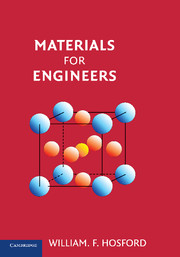Book contents
- Frontmatter
- Contents
- Preface
- 1 Introduction
- 2 Phases
- 3 Diffusion
- 4 Mechanical Behavior
- 5 Mechanical Failure
- 6 Annealing
- 7 Iron and Steel
- 8 Nonferrous Metals
- 9 Casting and Welding
- 10 Solid Shaping
- 11 Polymers
- 12 Polymer Processing
- 13 Glasses
- 14 Crystalline Ceramics
- 15 Powder Processing
- 16 Pottery and Concrete
- 17 Composites
- 18 Carbon
- 19 Fibers, Foams, and Porous Materials
- 20 Electrical Properties
- 21 Optical and Thermal Properties
- 22 Magnetic Materials
- 23 Corrosion
- 24 Modern Manufacturing Techniques, Surface Treatments, and Recycling
- APPENDIX 1 Wood
- APPENDIX 2 Miller Indices for Planes and Directions
- APPENDIX 3 X-ray Diffraction
- APPENDIX 4 Surfaces
- APPENDIX 5 Dislocations
- APPENDIX 6 Avrami Kinetics
- APPENDIX 7 Organic Chemistry
- APPENDIX 8 Average Molecular Weight
- APPENDIX 9 Bond Geometry in Compounds
- APPENDIX 10 Weibull Analysis
- Index
- Conversions
12 - Polymer Processing
Published online by Cambridge University Press: 05 June 2012
- Frontmatter
- Contents
- Preface
- 1 Introduction
- 2 Phases
- 3 Diffusion
- 4 Mechanical Behavior
- 5 Mechanical Failure
- 6 Annealing
- 7 Iron and Steel
- 8 Nonferrous Metals
- 9 Casting and Welding
- 10 Solid Shaping
- 11 Polymers
- 12 Polymer Processing
- 13 Glasses
- 14 Crystalline Ceramics
- 15 Powder Processing
- 16 Pottery and Concrete
- 17 Composites
- 18 Carbon
- 19 Fibers, Foams, and Porous Materials
- 20 Electrical Properties
- 21 Optical and Thermal Properties
- 22 Magnetic Materials
- 23 Corrosion
- 24 Modern Manufacturing Techniques, Surface Treatments, and Recycling
- APPENDIX 1 Wood
- APPENDIX 2 Miller Indices for Planes and Directions
- APPENDIX 3 X-ray Diffraction
- APPENDIX 4 Surfaces
- APPENDIX 5 Dislocations
- APPENDIX 6 Avrami Kinetics
- APPENDIX 7 Organic Chemistry
- APPENDIX 8 Average Molecular Weight
- APPENDIX 9 Bond Geometry in Compounds
- APPENDIX 10 Weibull Analysis
- Index
- Conversions
Summary
Cooling
Polymerization often releases a large amount of heat. Unless the heat is removed the reactants will become too hot.
Example Problem 12–1:
a. How much energy is released when one mole of phenol reacts with one mole of formaldehyde?
b. If the process were adiabatic (no heat released to the surroundings), how much would the temperature rise? The heat capacity of phenol formaldehyde is 1.193kJ/kg°C.
Solution:
a. Using the data in Appendix 7, the energy to break a C-O bond and an N-H bond is 360 and 430kJ/mole, and the energy released in forming a C-N bond and an O-H bond is 305 and 500kJ/mole. The net energy release is 805 −360 = 15kJ/mole.
b. The molecular weight of phenol formaldehyde is 90 g/mole (2O = 32 + 2N = 28 + 2C = 24 + 6H = 6) and the molecular weight of water is 18: ΔT = 15kJ/[(0.090kg) (1.193kJ/kg°C)+ 0.018kg)(4.186kJ/kg°C)] = 82°C. This would require cooling.
Injection Molding
Injection molding is similar to die casting of metals. A molten thermoplastic is injected into a metal mold at high pressure, and the molded part is ejected after it cools sufficiently. Injection molding is used to make a wide variety of parts, from small components to entire auto body panels. The most commonly used thermoplastics are polystyrene, ABS, nylon, polypropylene, polyethylene, and PVC. Although the properties of finished products benefit from a high molecular weight, very high molecular weights are not desirable for injection molding because viscosity increases with molecular weight.
- Type
- Chapter
- Information
- Materials for Engineers , pp. 125 - 129Publisher: Cambridge University PressPrint publication year: 2008



